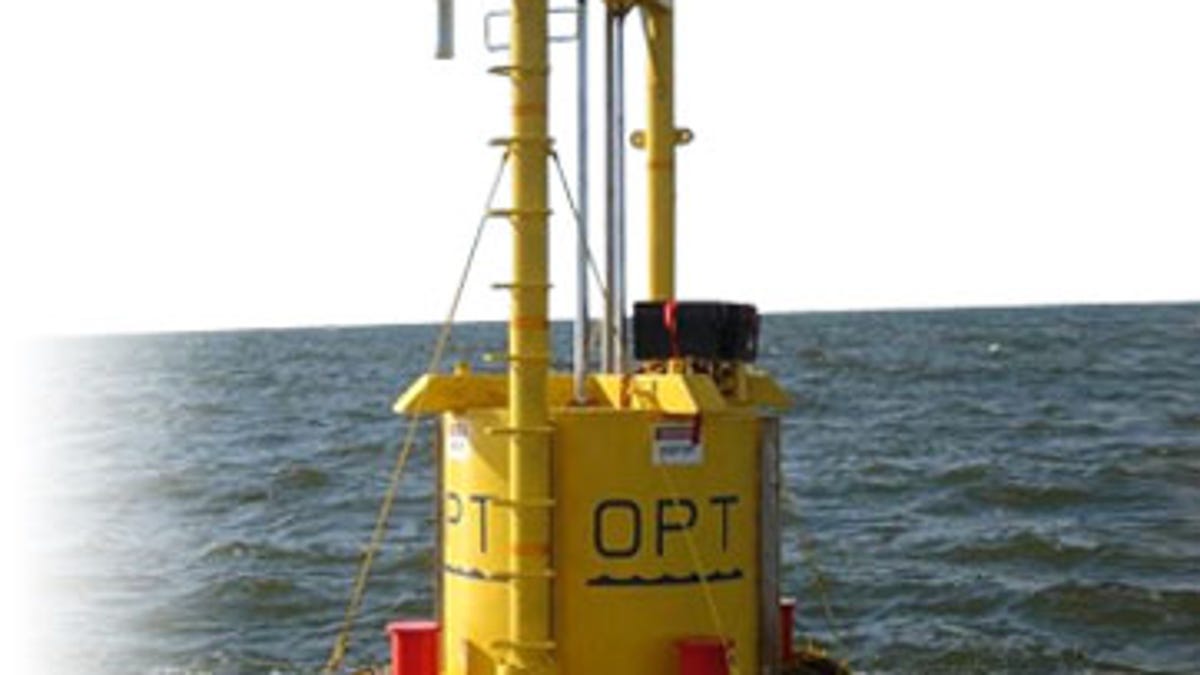Oregon on track to get utility-scale wave farm
Ocean Power Technology is in final-stage agreements to build wave energy project off Oregon's coast to power 1,000 homes.

Ocean Power Technologies announced Wednesday it's close to getting a license to build a wave energy plant off the coast of Oregon.
The New Jersey-based company has signed a settlement agreement that includes over 11 government agencies, and several private companies, to develop a 1.5-megawatt wave energy station.
When completed the plant will consist of 10 PowerBuoys that could generate enough electricity to power 1,000 homes annually, according to Ocean Power.
Ocean Power's PowerBuoys resemble ordinary ocean buoys from the surface, but hold a piston-like device inside that moves up and down with the natural jostle of ocean waves. The electricity generated by the movement is then sent to shore via underwater transmission cables. The buoys also contain onboard sensors and communication tools that allow the buoy to be monitored and adjusted to maximize its effect depending on the changing behavior of the ocean waves.
Oregon Iron Works is already constructing the buoys for the Oregon project, even though Ocean Power is still waiting to be granted its license with the Federal Energy Regulation Commission to connect to the grid, the company said in a statement.
Ocean Power participated in studies and investigations in conjunction with local government agencies to evaluate whether the project would have an effect on local marine life or the Oregon crabbing and fishing industries, among other concerns. As part of the settlement agreement, Ocean Power will also participate in a management plan to continually evaluate the project's impact on the local environment and fishing industry.
The project also has approval from the state's governor.
"The manufacture of the first buoy has already created dozens of green-energy jobs in Oregon and when the 10-buoy wave power project is built, a whole new industry will be created to benefit our coastal communities. This is an exciting time for our State and I look forward to continuing to foster this new industry in Oregon in a way that is sensitive to marine habitat and continues to value this important resource for Oregon's fishermen," Oregon Governor Ted Kulongoski said in a statement.
Ocean Power's buoys have already been placed in Hawaii. OceanPower won a $3 million contract in November 2008 from the U.S. Navy to develop a system that could be used in conjunction with communications tools for collecting data. They also have buoys set up in Kaneohe Bay, as part of a partnership project with the U.S. Marine Corps.
While it has not won support or adoption at the level of wind and solar, wave energy power has been gaining in popularity in recent years as government agencies and the private sector look to the ocean for affordable renewable-energy options.
Aquamarine Power won the "Innovator of 2009" award from Britain's Renewable Energy Association.
The Oyster 2 machine from Aquamarine Power is not a buoy at all, but a giant wave-harnessing machine that sits on the ocean floor. It uses a series of pistons activated by wave power to pump water through an underwater pipe system that leads to shore. The high-pressure water is then used to power a conventional hydro-electric generator. There are plans to install two of these machines in the Orkney Islands off the coast of mainland Scotland.
Independent Natural Resources in conjunction with the Marine Engineering Technology Department at Texas A&M University has developed the Seadog Pump. That buoy operates by pistons that respond as waves pass through a skeletal-like buoy. A series of Seadog buoys can be harnessed to both produce electricity and act as a desalination system.

